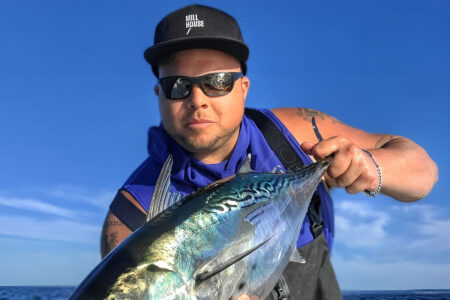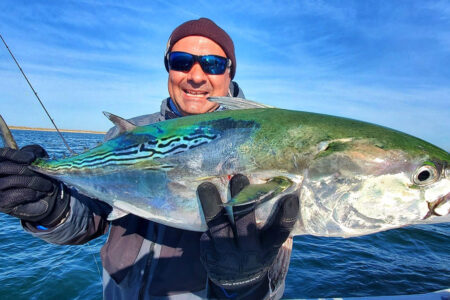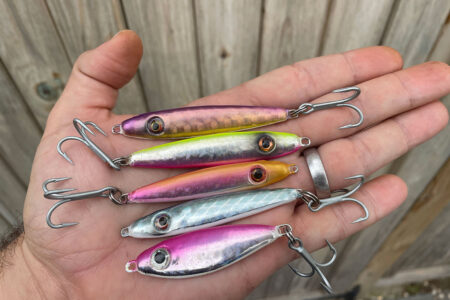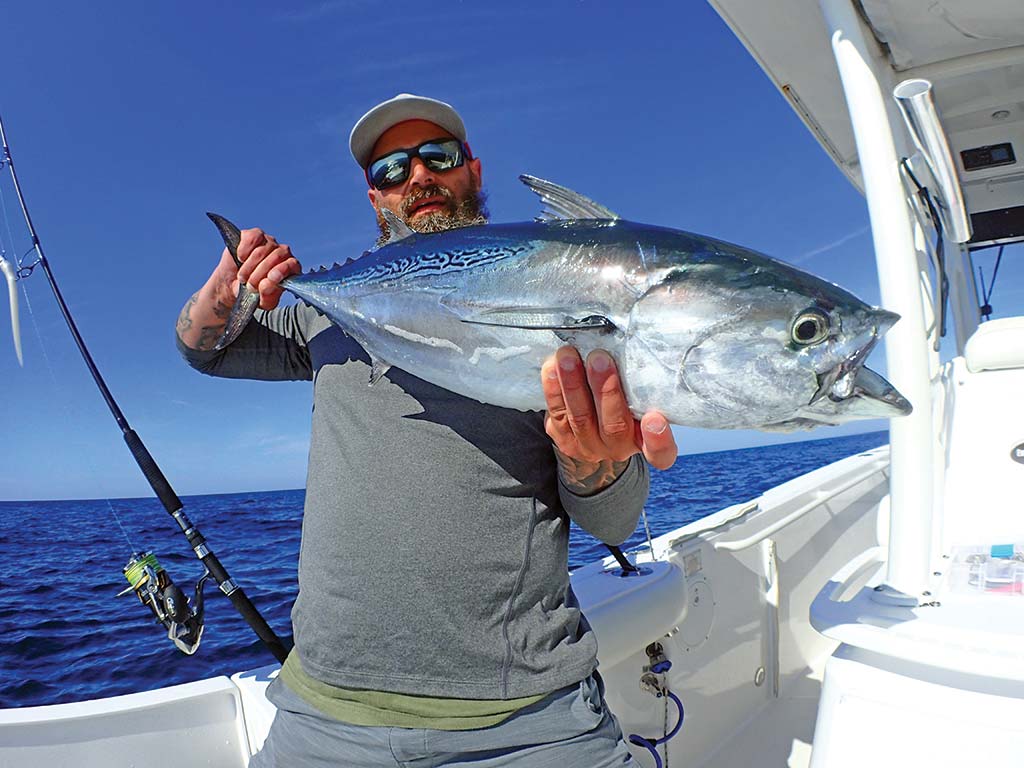
Using an offshore mindset to land giant albies inshore.
False albacore, albies, fat alberts, funny fish, (swordfish baits), whatever you happen to call them, the species known as little tunny, you can’t help but admire their speed, selective feeding behavior and brilliant coloration combined with some retro 90s tribal tattoo markings. These coastal “gateway” drugs to offshore tuna fishing are targets of opportunity that only visit for a brief period of time along the Northeast Coast each fall, but for some, albies are the focus of the entire angling season.
For most run and gunners or jetty hoppers, just lining up a clean shot at these fish or making a well-placed cast in front of their spontaneous feeds is an ever-constant challenge. However, over time you will begin to see the patterns and can eventually get a “feel” for where and when they will pop back up, or the lines they tend to travel. You become more in tune with the bait they feed on and the way they react to the tide and become more of a speed-fish specialist.
When you’ve reached the next level of hardtail hunting, where size matters and you’re not just trying to hook as many of them as humanly possible, it can seem like an insurmountable task. Albies are not your typical Northeast gamefish, like stripers, where you can find spots that repeatedly hold and produce bigger fish. By definition, pelagic species are fish that don’t relate to structure, they inhabit the upper reaches of the water column and, most pelagic species (false albacore being one), have to keep moving to stay alive.
Blazing Trails
Don’t be afraid to go vertical. I mark and butterfly/vertical jig large false albacore frequently off the south shore of Rhode Island and Block. Whenever the fish are popping few and far between but they are popping, and you have lots of “life” on sonar, this is when it’s a good idea to “deploy” the probe as we like to say. In addition to the blind pitch don’t be reluctant to get some metal moving vertical through the water column through all those marks. I like to get some vertical jigs of multiple profiles and sizes working hard and fast from the bottom strait up to the surface in this scenario. It’s often rewarded with a swift stop and bend on one of the rapid lifts.
To begin with, you’re going to have to double up on your hypertension meds and ignore those frantic feeds that are driving all the run-and-gun guys crazy. Most of the time those schools are going to be made up of the smaller albies that you’ve been catching your whole life. It’s definitely a good idea to watch the schools for a minute or two, because you never know, but 98 percent of the time, you’re better off moving on in search of bigger bait and taking advantage of the offshore tendencies of the big ones.
Seeing albies feeding in a general area is a good thing though. Once you’ve honed in on an area holding fish, you need to look at the region you’re fishing more like an overhead battle map to line up a shot at the “fattest Albert” you might meet. Start by checking your chart for areas with a steep drop off, offering access to the deeper waters from offshore. Then try to line that up with as much tidal current as possible.
Living Large
Larger albies come from deeper offshore waters and feed more sporadically, like their deeper water offshore cousins. Finding hard current seams with access to deep water and a concentration of bait will create one of the few recognizable feeding opportunities for the bigger guys. That is especially true if that area has any floating debris or weeds that can provide small points of cover for larger baitfish which tend to travel in smaller schools than the more common inshore baits like anchovies and peanut bunker.
Then shift your focus to looking for larger baitfish like those leaping cigar minnows, halfbeaks, tinker mackerel or squid. Most of these bait sources can be identified as larger bait spraying out of the water or, as they tend to do, leap-frogging in small waves. However they can also be identified by showing up as smaller bundles of concentrated bait in the mid to lower water column on sonar. Especially squid, which will look like an elongated blob on the screen, we call those marks “anacondas” jokingly when out on the hunt for bait sources. When you’ve found deeper water access near some of the inshore action and have the larger baits in place, you’re in the right zone. Now you want to adjust one more thing, the approach. Treat these small tuna, just like you should, as “small tuna.”
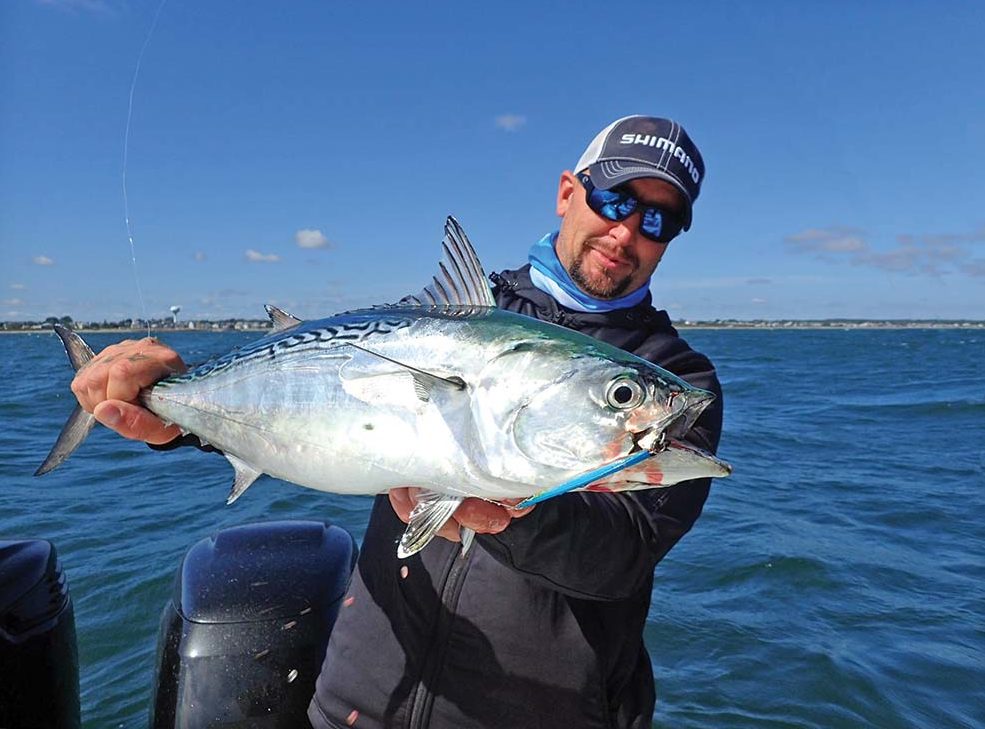
Treat ‘Em Like Tuna
We encounter XXL false albacore all the time when targeting coastal bluefins from the backside of Cape Cod all the way down to waters south of New Jersey. Some of the best action every year happens between Gay Head on Martha’s Vineyard and the waters south of Montauk. Don’t be afraid to fish larger lures – albies hit large tuna jigs, jerkbaits and will even readily take trolled ballyhoos, Zukers and even bigger offerings like spreader bars and deep diving swimmers trolled 30-feet down on heavy fluoro.
Of course, catching even huge albies on this kind of gear really dumbs down the fight, but if you want to draw the attention of these outsized fish you have to throw bigger baits. So cast larger offerings like 6 or 8-inch Ron-Z’s or weightless 7 or 9-inch Slug-Go’s and jerkbaits like the Shimano Coltsniper Jerk. When encountered inshore, XXL albies are seldom part of large surface feeds, their occurrence is much more random and, in many cases, they are caught in solo situations as bycatch. This is because they tend to break up into smaller hunting packs when in shallower coastal waters.
When you do encounter schools of these larger fish, do your best to ‘match the hatch,’ so you can fish the standard line up of ‘albie jigs’ like epoxies, Coltsnipers, smaller plastics like 4 and 6-inch RonZ’s and Slug-Go’s, also topwaters like Shimano Coltsniper Walk in ‘hi-pitch’ and a lifelike finish or a Rebel Jumpin’ Minnows in bone.
When possible try to lead (cast in front of) the feed and try to position yourself so that your bait will be running away from them in the same direction they are moving. Don’t hammer down on the smaller feed or cast directly into the feed as you are far less likely to come tight. If they are very sporadic, which they often are, but popping in a relatively consistent area which they often do, fish the school of bait or the most obvious tide seam blind and have patience, I like to tell my clients “just believe” and stay on it. Remember you’re looking for one “big one” here, you can always go in and play with the “regulars” if you can’t take the waiting game. In fishing, as in life, most things worthwhile don’t happen quickly or easily. Preparation, focus and time spent are what separate the consistently successful from the frustrated social media trolls.
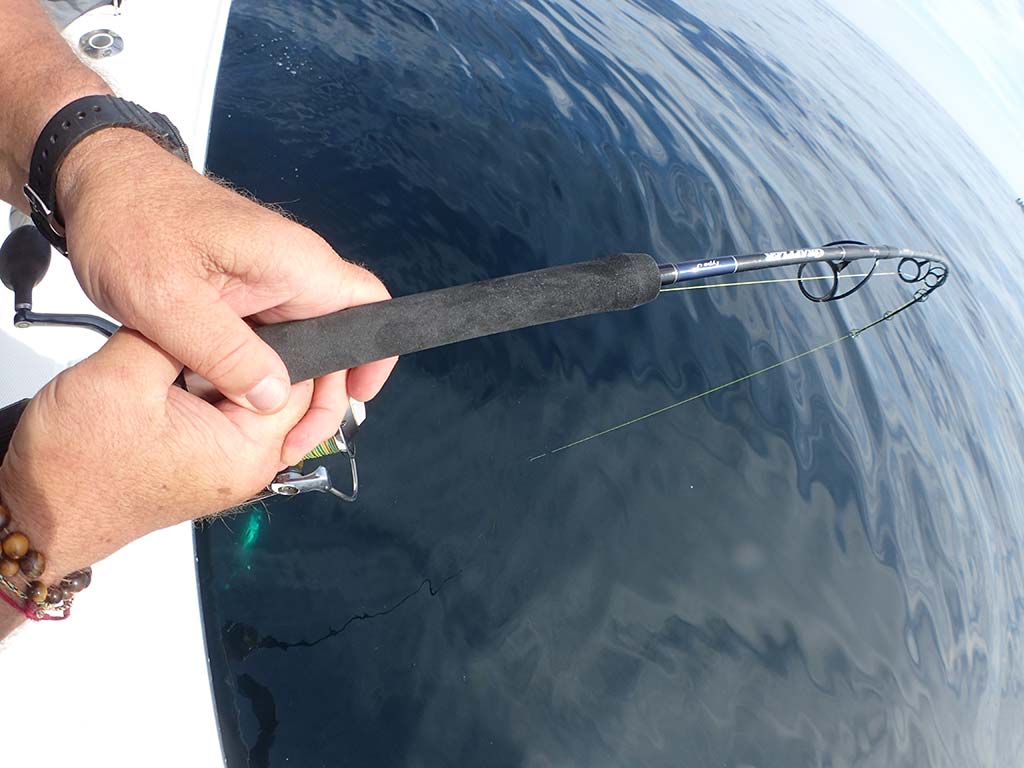
Armed & Ready
These fish are 4 to 8 pounds heavier than most of the smaller fish we target inshore and are capable of breaking the tips off some some of the lighter inshore setups. So, in some cases, it’s not a bad idea to break out your striped bass class gear to cast to them. For me it’s a 4000 or 5000 class reel like a Shimano Twin Power SW or if you’re on a tighter budget the New Spheros SW. Both have infinity drive for more cranking power when under heavy load, much better suited for getting the fish up and out of the spin. I match those with medium class set ups like G.Loomis IMX Pro Blue 843S F or Shimano NE Teramar XX Series TXNSX70M. I spool these set ups with 30-pound PowerPro SuperSlick V2 and tie an FG knot to a 20 to 25-pound fluorocarbon leader. The fish are not as leader shy as their smaller counterparts so the beefed up leader is a non-issue for these big guys.
When you’re marking bait and fish but they’re not taking jigs and they’re not popping up at all, sometimes you’re better off to deploy a small spread of swimming lures and try trolling. X-Raps are probably the most popular swimmer for albie trolling, but small birds and Green Machines will draw strikes too. Try trolling up and down current first then across it down and then up in different directions. Mix up your speeds between 5 and 7 knots. When you get hit, try to replicate your direction and speed of success.
For jigging I like a slightly larger reel for cranking and if spinning, will beef up to a 6000 size Shimano Twin Power or Spheros matched to a Shimano Grappler Jigging Series GRPJS60M. On the conventional side, an Ocea Jigger 2000 or 16 class reel like a Shimano Trinidad or Torium matched with a grappler GRPCJ60M works well, just be sure to match the gram ratings of the jigs you intend to use properly to the blanks you select for proper performance. I spool my jigging reels with 30-pound PowerPro Depth Hunter so I can use the metered color changes to drop to targets at the exact depth I mark them at. Your entire leader system is exposed to the fish in this scenario, since you’re fishing for them vertically, so I tie a PR bobbin knot to a 15 to 20-foot length of 25 to 30-pound fluorocarbon leader, and that to a solid ring with an assist hook that I can use to simply attach any of the jigs I want to fish via a split ring.
If you want the bigger fish, it’s a matter of getting outside the simple “sheeple” approach to targeting false albacore. Running and gunning or stalking and ambushing while tossing micro offerings on light leaders then burning them across the surface will always get you tight on the smaller fish. When you find yourself wanting to tangle with something bigger and meaner, you’ll have to take your approach to a more specific, and size-focused program. Get outside the pack, go deep, go big and introduce yourself to Big Al!

